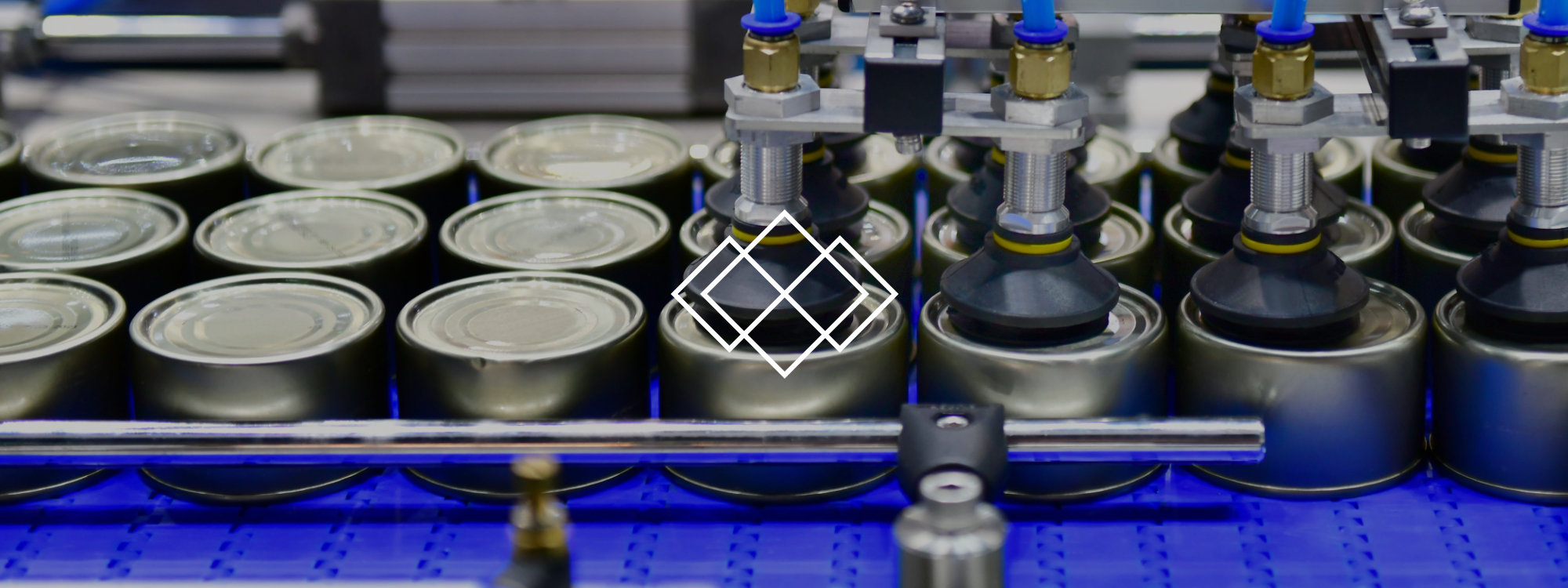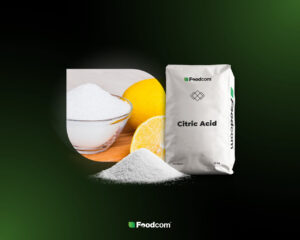Read our comprehensive guide to 10 of the most commonly used food additives. Learn what they are, how they are classified in the EU, and for what purpose they are added to foodstuffs. Discover in detail how you can use each of the listed additives in food production and what benefits do they offer.
What are E food additives?
In the European Union, food additives are classified under symbol E (Europe) with a respective number. However, a majority of them are also commonly applied in food production all over the world. In the EU, food additives are substances added to food products but are not considered to be consumed as food by itself. Food additives may or may not have nutritional value. The European Union recognizes 26 technological purposes of using food additives, mainly to add or restore the color of the food item, prolong its shelf life, protect it from oxidation, enhance its sweetness, or build a desired texture. The European Food Safety Authority (EFSA) is responsible for analyzing the safety of food additives and their acceptable level in foodstuffs.
MALIC ACID – E 296
Malic acid is a naturally occurring acid present in unripe fruits and vegetables. However, commercial malic acid is usually obtained by chemical hydration of maleic or fumaric acid with the use of high temperatures and high pressure. Malic acid has a smooth, tart or sour taste and no foreign odors. It is highly soluble in water but has a lower hygroscopicity rate than citric acid.
How to use malic acid (E296)?
Malic acid is widely applied as a preservative. It is also commonly used as a sweetness or tartness enhancer in fruit and vegetable juices, powdered iced tea, carbonated soft drinks, jams, chewing gums, and candies. It prolongs the release of fruit flavors and creates a sensation of a stronger aroma. The product enhances and preserves the taste of dressings, sauces, and mayonnaise by preventing rancidification in fats and oils. In the wine industry, malic acid is used as a basis for malolactic fermentation allowing the manufacturers to produce wines of softer taste.
ASCORBIC ACID – E 300
Ascorbic acid, also known as vitamin C, is a natural antioxidant occurring in many fruits and vegetables. Commercial production of ascorbic acid involves bacterial fermentation and the chemical oxidation of glucose. The product comes in the form of fine, white powder with a characteristic acidic taste and no odor. Ascorbic acid is soluble in water and other liquids. It is highly susceptible to high temperatures.
How to use ascorbic acid (E300)?
Ascorbic acid also has texture-altering properties. In confectionery and baked goods, the addition of ascorbic acid increases the bread volume and changes the texture of the dough. It acts as a preservative in meat, fish, and vegetable products prolonging the shelf life of these items and preventing fermentation and oxidation. It also helps to preserve the color in fruit and meat goods. In alcoholic beverages such as beer and wine, ascorbic acid acts as an enhancer of taste and transparency.
CITRIC ACID – E 330
Citric acid is naturally found in citrus fruits but can also be manufactured. Industrial citric acid is produced mainly through fermentation with the use of enzymes and microbial strains, most commonly of Aspergillus niger.
How to use citric acid (E330)?
Around 75% of the industrially produced citric acid is used in the food and beverage sector. The product is an excellent preservative commonly added to canned and jarred goods to help preserve their freshness. It also serves as a binding agent and thickener in sauces, creams, jellies, marmalades, and jams. Moreover, citric acid acts as an acidulant, antioxidant, and flavor enhancer in fruit-based products. In confectionery and baked goods, it improves the leavening of baking soda. The product is also used to adjust the pH solutions in the process of beer brewing and wine manufacture. In the dairy sector, citric acid is used for cheese manufacture and processing. It supports the stabilization of emulsions and prevents fat separation.
AGAR – E 406
Agar is a polysaccharide obtained from seaweeds, used to modify the physical properties of the product. It contains high levels of soluble dietary fibers and is characterized by high water-retention properties.
How to use agar (406)?
Agar is widely used due to its emulsifying, gelling, thickening, and stabilizing properties. It is a vegan-friendly substitute for gelatin. The product is applied in the production of baked goods, confectionery items, dressings, sauces, creams, fillings, and soups. In fruit beverages, agar helps to uniformly suspend the particles and extend shelf life. In meat products, it acts as a binding agent. Agar also finds its use in vegetarian foodstuffs and dietary items.
XANTHAN GUM – E 415
Xanthan gum is a polysaccharide, most commonly obtained from plants such as corn or cane sugar by fermentation with the use of Xanthomonas campestris bacteria. The product is characterized by high solubility and viscosity rates.
How to use xanthan gum (E415)?
Xanthan gum is applied as a thickener, texturizer, and stabilizer among others. The product allows suspending spice particles and flavor enhancements in ‘light ‘or ‘reduced-calorie’ goods. In gluten-free products, it improves texture and suspension while in vegan products, it provides viscosity that would normally be achieved by using eggs. Various properties of the xanthan gum are used in products including salad dressings, condiments, syrups, sauces, meat, sausages, baked goods, frozen items, and ice cream. The chemical structure of xanthan gum provides clean organoleptic properties, especially in liquid and fluid items. It stabilizes emulsions, suspensions, and aqueous dispersions and prevents the products from thickening upon cooling, thus allowing a smooth flowability in pumpable and squeezable items. The product is stable in low pH environments and very low temperatures. In bakery mixes and flour-based preparations, xanthan gum improves fluffiness, ensures moisture retention, and increases cake volume.
TARA GUM – E 417
Tara gum, also known as Peruvian carob, is a fully natural ingredient widely used as a food additive. It is produced from the seeds of Caesalpinia spinosa – a plant from the Leguminosae family, found in South America in the regions of Peru and Bolivia. It is highly soluble in warm water and less soluble in cold liquids. Furthermore, it is odorless and tasteless and provides a good flavor release in food products. The product is also easily mixed with other hydrocolloids for increased viscosity and gel elasticity. Tara gum is suitable for halal, kosher, and vegan diets.
How to use tara gum (E417)?
Tara gum has an extensive range of properties used in the manufacture of foods, including an extensive portfolio of low-fat goods. It is characterized by excellent thickening and viscosity improvement properties widely used in products such as condiments, sauces, dressings, jellies, jams, fruit fillings, dairy-based desserts, puddings, and yogurts. Its water-retention abilities provide soft texture, moisture, and prolonged freshness in baked goods such as bread, buns, cakes, and gluten-free baked items. The use of Tara gum prevents ice crystals formation in frozen products such as ice-creams, sorbets, and desserts. In meat-based products, it is responsible for water retention, gel structure improvement, and meat replacement in goods such as sausages, frankfurters, cooked hams, hot dogs, and hamburgers. In spreads and cheese-based items, the product improves the viscosity, provides a shiny surface, and reduces whey syneresis.
PECTIN – E 440
Pectin is a heteropolysaccharide naturally occurring in some fruits. It is obtained commercially in acid conditions from citrus rinds of lemons, limes, and oranges. The product has high gel-forming and thickening properties.
How to use pectin (E440)?
Pectin is an essential ingredient found in jams and jellies to help them set and enhance their thickness. It is characterized by excellent gelling, stabilizing, and emulsifying properties. It also enhances the delicateness of fruit jams, reduces preparation time, improves fluidity, and extends shelf life. Furthermore, it is also used as a flavor enhancer in juices, fruit beverages, and soft drinks, especially in items of reduced sugar content. In a range of beverages, pectin is used to improve mouthfeel, enhance flavor release, and stabilize other components. The product is also applied in the production of hard candies, gummies, and yogurts.
CALCIUM SULFATE – E 516
Calcium sulfate is a natural mineral, most commonly occurring as gypsum. It is characterized by a very low solubility rate in water and other solvents.
How to use calcium sulfate (E516)?
Calcium sulfate offers a range of texture-altering properties in various industries. It is used as a thickener, stabilizer, desiccant, anti-binder, and chelating agent among others. Moreover, it regulates the pH to obtain the desired acidity of the final product and allows pH control during beer brewing. In the bakery sector, calcium sulfate is used to fortify the texture of bread, cookies, cakes, and confectionery items. It acts as an anticaking agent, preventing lumping and agglomeration. It also strengthens the dough by modifying starch, improves yeast leavening, enhances texture, and supports the structure of the product. In China, calcium sulfate has long been used as a thickening agent and coagulant in the production of tofu from soy milk to obtain a tender and brittle structure. Other benefits of calcium sulfate include reduction of sodium levels and extension of shelf life in canned vegetables, jarred jellies, frozen foods, and beverages.
ASPARTAME – E 951
Aspartame is a very intense artificial sweetener of low caloric value. It is considered to be 200 times sweeter than sugar. Commercial aspartame is available in the form of white, odorless powder. The product breaks down at high temperatures and is therefore not suitable for high-heat treatment. Aspartame is one of the most thoroughly studied food additives and has been considered safe to consume on several occasions by the European Food Safety Authority (EFSA), most recently in 2020.
How to use aspartame (E951)?
Aspartame is mainly used as a sweetener and flavor enhancer in a wide range of food items such as candies, confectionery goods, flavored beverages, desserts, and drinks. Aspartame provides a clean, sweet flavor without a metallic aftertaste.
ERYTHRITOL – E 968
Erythritol is a type of carbohydrate known as polyol, otherwise referred to as alcohol sugar. However, it does not contain nor alcohol nor sugar but has the chemical characteristics of both. Erythritol naturally occurs in some fruits and fermented goods but can also be produced industrially. Commercial erythritol is obtained by fermentation of glucose or fructose with the use of various yeasts and other microorganisms. The raw material used for erythritol production is usually corn or fermented fruits unfit for direct human consumption. The product is gluten-free and suitable for vegan, vegetarian, paleo, and keto diets. Erythritol is 60-70% less sweet than sucrose and has a distinctive, fresh mouthfeel with slight acidity. It is less soluble in water and less viscous than sucrose and other sugars. It has a very low caloric value – much lower than other sugars, and is therefore commonly applied in reduced-calorie and sugar-free goods.
How to use erythritol (E968)?
Together with other sweeteners, erythritol is added to many products to enhance their sweetness and balance the flavor by providing a limited supply of calories. It is added to foodstuffs such as yogurts, chocolate bars, candies, and jellies. It is a common ingredient of sugar-free soft drinks and beverages. In solid foods, erythritol is used as a bulking and thickening agent to add weight and volume to the product. It is also used to limit moisture adsorption in fruit bars, flour mixes, and coatings. It acts as a softener in chewing gums and hard candies. In baked goods and confectionery, erythritol improves structural tightness and softness.
Want to learn more? Choose Foodcom as your business partner!









